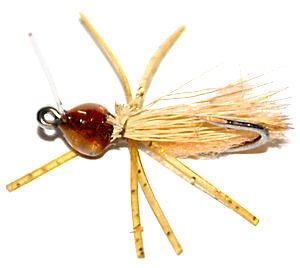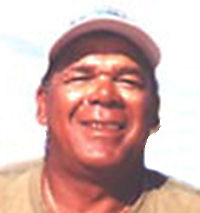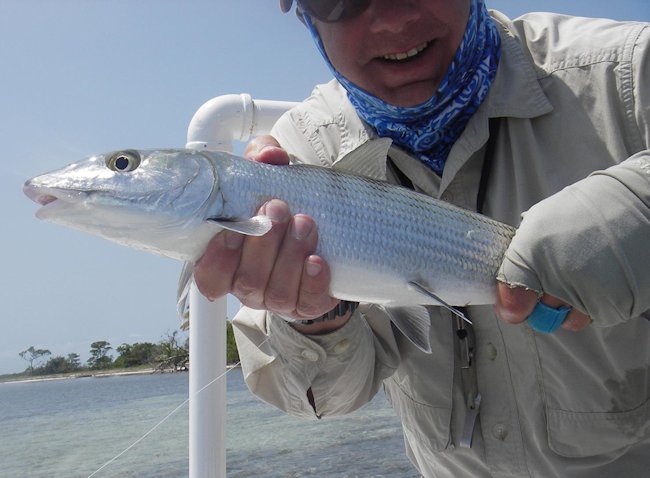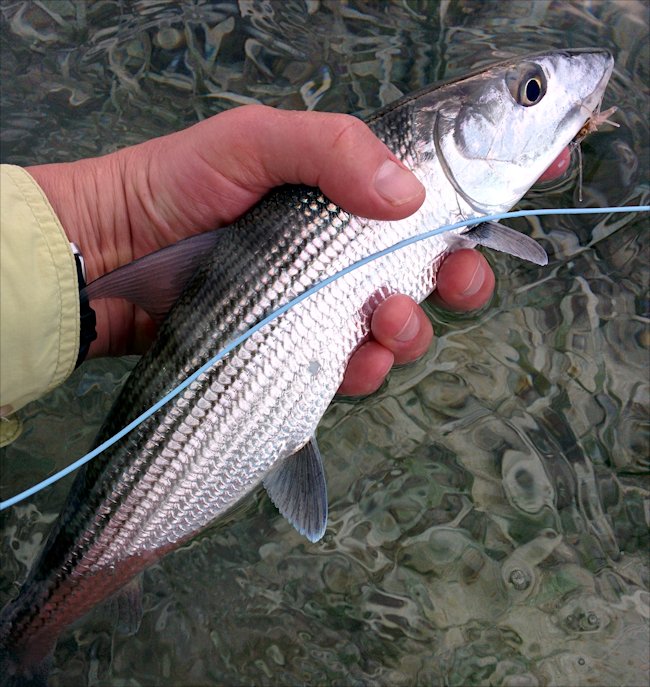Bitter Small Tan Crab fly
When fishing over a sandy sea bottom for Permit or Bonefish then use a Tan Bitter to imitate the small local tan colored crabs that are a staple part of these saltwater fish's diet.

POP'S BONEFISH BITTER SMALL CRAB PATTERN. Hook size 8 6 4 - $US each
Fly fisherman Craig Matthews designed this small crab pattern. He named it Pop’s Bonefish Bitter, after Winston "Pops" Cabral his friend and fishing guide at Turneffe Flats Lodge on the Turneffe Atoll in Belize. Pops was born and raised in Belize City. He started his working life at the young age of 14 with his family as a commercial fisherman in the Turneffe Islands. He guided at the southern end of Turneffe Island for a number of years before moving to Turneffe Flats Lodge in 1987. Craig learnt a lot from this master flats saltwater fly fisherman. Although Pop’s Bonefish Bitter was originally designed for Bonefish I have caught more Permit fish with this fly than bonefish. The Brown Pop's Bitter was developed for the mud bottom lagoons that can be found south of Placencia in Belize. I try to cast the fly so that it lands about six feet ahead of any cruising permit. I let it settle on the bottom. I wait until the permit gets within about two feet of my Bitter fly and then give the line a couple of quick sharp twitches to make the fly look like it is trying to burrow into the mud. This will send out a small puff of mud which will act as a signal to the permit that there is life down on the sea bed trying to hide. I check that the line is tight when the fly lands and settles on the bottom. The strike can be difficult to detect if there is slack in the line.I use a line pull to set the hook. The white tan and yellow Pop's Bitters are great for light sand beaches like those in the Bahamas or Cuba. I choose the fly that matches the colour of the sea bottom.In nature if you can be seen your dead. Most prey species of the bonefish are very well camouflaged. Your fly must not mimic nature too well for if it cannot be seen you will not catch fish. Bonefish know that if they reach the crest of a flat on an incoming tide they will find the best food waiting for them. Look at your tide tables and find the crest. Sometimes schools of Bonefish will rush towards there as the tide turns and starts to flood. Getting a take is all about placement and delivery in front of your target.

The above photograph is of Winston "Pops" Carbral, the Turneff Flats saltwater fly fishing guide who helped Craig Matthews develop the Bitter small crab fly that is so successful in catching Bonefish and Permit fish in Belize.
One little tip is to keep your hands clean. Bonefish and permit have a powerful sense of smell. They can smell crabs and shrimps they cannot see. They can also smell, insect repellant, beer, sunblock, gasoline and aftershave. I wasted a whole days fishing. I was using a lot of sunblock because I did not want to get sunburnt as I had very white English skin that had not seen the sun for five months. I was getting frustrated an being the only one not catching fish when my guide pointed out my error. After I thoroughly cleaned my flies my luck changed.

The above photograph shows Steve Burns proudly holding a permit fish he caught in Belize using our Bitter small crab fly patterns. It is very sensible to wear clothing that will prevent you getting very badly burnt by the Caribbean sun. So as not to spook the permit and bonefish do not wear bright colors when fishing on the flats. Pale blue or white makes you harder to be seen by your target fish. You merge with the color of the sky.
Bonefish very rarely take with a 'bang'. They catch up with the fly and suck it in. All you normally feel is a change in tension on the line as you strip. That is the only indication you get that the bonefish has taken your fly. Beginners tend to strike with the rod, lifting it as you might lift into a trout taking a dry fly. What you should do is the moment you feel the fly being sucked in by the fish, you keep stripping hard. You will find that the line will tighten, at which point strip/strike the line with the rod tip still pointing at the fish, only lifting the rod when your sure the hook is home. That is when the Bonefish will take off. You better be ready for the fight and hold on tight to your rod. These fish pack a punch.. On my first Bonefish trip I made the mistake of using a fly rod that reflected the sun. It spooked the fish again and again. I now use a dark matt carbon rod with no shiny parts. Fish that are very prone to aerial predator attack get very spooky.
Recent studies have found that although bonefish and permit come to the flats to feed and appear to swim to deeper water when spooked by anglers the main reason they prefer the flats is safety. Barracudas and sharks are their main predators. The water over the flats is just too shallow for these larger hungry water dwellers. Bonefish and permit can therefore feed in relative safety on shrimp and crabs

This small Bonefish was caught on a tan Bitter crab fly pattern
Customer's Photo
I was staying on the South Water Caye, Belize at a very small private resort called Pelican Beach www.pelicanbeachbelize.com. This small island sits right on the Messoamerican reef. It offers great Bonefishing literally a few yards from your hut. However, they offer no services to fishermen ... you're on your own. I did meet up with a local guide, a very young Norwegian who was a wild as the sea and had a jaw dropping cast.... Attached are two pics, one of the reef and the other of a small Bone who took a tan Bitters, the weed guards are great if you're fishing in the sea grass. On the flats that I fished daily there was always at least one school of 20 or so Bonefish feeding , best time was on the incoming or outgoing tide. There were Permit in the area (deeper water) and tarpon. This is a great destination for a couple, very laid back, all inclusive, and not a very many other fishermen to compete with. Bill Carey


Permit fishing books

